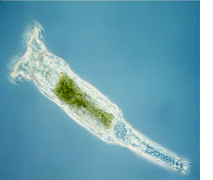| |
 
January 2004, Vol. 13, No. 1 | Return to Table of Contents
An Evolutionary Exception Confirmed
MBL Researchers Provide Strong Evidence that an Ancient Microbe Thrives and Evolves Without Sex
 Bay Paul Center biologist Jessica Mark Welch and her colleagues David Mark Welch and Matthew Meselson have confirmed that a group of microscopic animals has evolved for tens of millions of years without sexual reproduction. Their results demonstrate a radical exception to the biological rule that abandonment of sexual reproduction is an evolutionary dead end. Bay Paul Center biologist Jessica Mark Welch and her colleagues David Mark Welch and Matthew Meselson have confirmed that a group of microscopic animals has evolved for tens of millions of years without sexual reproduction. Their results demonstrate a radical exception to the biological rule that abandonment of sexual reproduction is an evolutionary dead end.
While almost all multicellular organisms reproduce sexually, this form of reproduction is much less efficient than asexual reproduction (or mitosis) whereby females effectively make clones of themselves. Although asexual organisms often enjoy short-term success against their sexual ancestors, they are rarely found as higher-order taxa, implying that they cannot survive in evolutionary time.
While many hypotheses have addressed this problem, the paradox raises one of the most perplexing questions in biology: If asexual reproduction is more efficient than sexual reproduction, why does sexual reproduction predominate so thoroughly? New research from the evolutionary biologists may help scientists come closer to an answer.
In a recent paper published in Proceedings of the National Academy of Sciences (PNAS), Mark Welch and her colleagues provide the strongest evidence to date that a higher-ranking taxon has evolved without sexual reproduction.
The researchers studied the bdelloid rotifer, a microscopic animal found throughout the world in almost all aquatic habitats. Bdelloids appear to have given up sex 50 million years ago, yet the organism has evolved into 370 described species. While the researchers previously demonstrated that bdelloid genomes contain two or more divergent gene copies, an observation consistent with long-term asexual reproduction, a significant shortcoming of their approach was the inability to detect nearly identical gene pairs, as might result from inbreeding or other rare forms of sexual reproduction.
To overcome this methodological shortcoming and conclusively demonstrate that bdelloids are, in fact, completely asexual, Mark Welch and her team painstakingly analyzed the genome of the bdelloid species, Philodina roseola. Using a method called fluorescent in situ hybridization, they scoured the genome, looking for chromosome partners, also called homologous pairs. Identificationof these would be a clear indication of sexual reproduction as each member of the chromosome pair is derived from a different parent.
The researchers identified four copies of a target P. roseola marker gene, however each gene was on a separate chromosome and all were quite a bit different from each other. These results, consistent with asexual reproduction, eliminate the possibility that bdelloids reproduce sexually and thus confirm that the organism has evolved without sexual reproduction or genetic exchange for tens of millions of years.
What drives early extinction, and why it can be averted by sex, remains one of the central mysteries of biology, the resolution of which is likely to have far-reaching impact on scientists’ understanding of basic biological and evolutionary processes. “Sex and genetic recombination are obviously tremendously important for life,” says Jessica Mark Welch, “but we don’t understand why they are so important. When we do eventually understand, it could have practical consequences we can’t yet imagine.”
Mark Welch and her colleagues will continue to study bdelloids as they offer an ideal model system in which to explore the effects of asexual reproduction. Their hope is to better understand how the animals have evolved without sexual reproduction and escaped extinction. “We can now use belloid rotifers to test the theories about why sex is important,” says Mark Welch. “Any good theory will now have to account for why the bdelloids are an exception.”
|